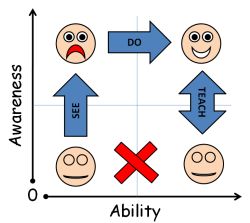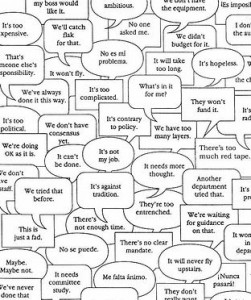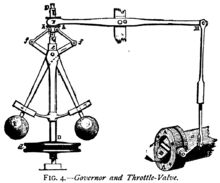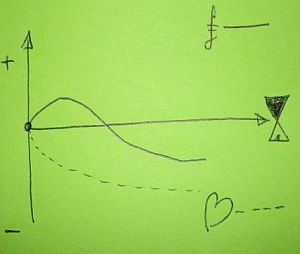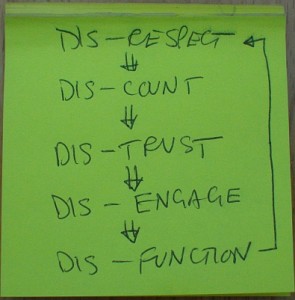 <Ring Ring><Ring Ring>
<Ring Ring><Ring Ring>
B: Hello Leslie. How are you today?
L: Hi Bob – I am OK. Thank you for your time today. Is 15 minutes going to be enough?
B: Yes. There is evidence that the ideal chunk of time for effective learning is around 15 minutes.
L: OK. I said I would read the material you sent me and reflect on it.
B: Yes. Can you retell your Nerve Curve experience as a storyboard and highlight your ‘ah ha’ moments?
L: OK. And that was the first ‘ah ha’. I found the storyboard format a really effective way to capture my sequence of emotional states.
 B: Yes. There are close links between stories, communication, learning and improvement. Before we learned to write we used campfire stories to pass collective knowledge from generation to generation. It is an ancient, in-built skill we all have and we all enjoy a good story.
B: Yes. There are close links between stories, communication, learning and improvement. Before we learned to write we used campfire stories to pass collective knowledge from generation to generation. It is an ancient, in-built skill we all have and we all enjoy a good story.
L: Yes. My first reaction was to the way you described the Victim role. It really resonated with how I was feeling and how I was part of the dynamic. You were spot on with the feelings that dominated my thinking – anxiety and fear. The big ‘ah ha’ for me was to understand the discount that I was making. Not of others – of myself.
B: OK. What was the image that you sketched on your storyboard?
L: I am embarrased to say – you will think I am silly.
B: I will not think you are silly.
 I know. And I knew that as soon as I said it. I think I was actually saying it to myself – or part of myself. Like I was trying to appease part of myself. Anyway, the picture I sketched was me as a small child at school standing with my head down, hands by my sides, and being told off in front of the whole class for getting a sum wrong. I was crying. I was not very good at maths and even now my mind sort of freezes and I get tears in my eyes and feel scared whenever someone tries to explain something using equations! I can feel the terror starting to well up just talking about it.
I know. And I knew that as soon as I said it. I think I was actually saying it to myself – or part of myself. Like I was trying to appease part of myself. Anyway, the picture I sketched was me as a small child at school standing with my head down, hands by my sides, and being told off in front of the whole class for getting a sum wrong. I was crying. I was not very good at maths and even now my mind sort of freezes and I get tears in my eyes and feel scared whenever someone tries to explain something using equations! I can feel the terror starting to well up just talking about it.
B: OK. No need to panic. Take a long breath and exhale slowly. The story you have told is very common. Many of our fears of failure originate from early memories of experiencing ‘education by humiliation’. It is a blunt and ineffective motivational tool that causes untold and long lasting damage. It is a symptom of a low quality education system design. Education is an exercise in improvement of knowledge, understanding, capability and confidence. The unintended outcome of this clumsy teaching tactic is a belief that we cannot solve problems ourselves and it is that invalid belief that creates the self-fulfilling prophecy of repeated failure.
L: Yes! And I know I can solve maths problems – I do it all the time – and I help my children with their maths homework. So, it is not the maths that is triggering my fear. What is it?
B: The answer to your question will become clear. What is the next picture on your storyboard?
 The next picture was of the teacher who was telling me off. Or rather the face of the teacher. It was a face of frustration and anger. I drew a thought bubble and wrote in it “This small, irritating child cannot solve even a simple maths problem and is slowing down the whole lesson by bursting into tears everytime they get stuck. I blame the parents who are clearly too soft. They all need to learn some discipline – the hard way.“
The next picture was of the teacher who was telling me off. Or rather the face of the teacher. It was a face of frustration and anger. I drew a thought bubble and wrote in it “This small, irritating child cannot solve even a simple maths problem and is slowing down the whole lesson by bursting into tears everytime they get stuck. I blame the parents who are clearly too soft. They all need to learn some discipline – the hard way.“
L: Does this shed any light on your question?
B: Wow! Yes! It is not the maths that I am reacting to – it is the behaviour of the teacher. I am scared of the behaviour. I feel powerless. They are the teacher, I am just a small, incompetent, stupid, blubbing child. They do not care that I do not understand the question, and that I am in distress, and that I am scared that I will be embarassed in front of the whole class, and that I am scared that my parents will see a bad mark on my school report. And I feel trapped. I need to rationalise this. To make sense of it. Maybe I am stupid? That would explain why I cannot solve the mths problem. Maybe I should just give in and accept that I am a failure and too stupid to do maths?
There was a pause. Then Leslie continued in a different tone. A more determined tone.
L: But I am not a failure. This is just my knee jerk habitual reaction to an authority figure displaying anger towards me. I can decide how I react. I have complete control over that. I can disconnect the behaviour I experience and my reaction to it. I can choose. Wow!
B: OK. How are you feeling right now? Can you describe it using a visual metaphor?
 L: Um – weird. Mixed feelings. I am picturing myself sitting on a giant catapault. The ends of the huge elastic bands are anchored in the present and I am sitting in the loop but it is stretched way back into the past. There is something formless in the past that has been holding me back and the tension has been slowly building over time. And it feels that I have just cut that tie to the past, and I am free, and I am now being accelerated into the future. I did that. I am in control of my own destiny and it suddenly feels fun and exciting.
L: Um – weird. Mixed feelings. I am picturing myself sitting on a giant catapault. The ends of the huge elastic bands are anchored in the present and I am sitting in the loop but it is stretched way back into the past. There is something formless in the past that has been holding me back and the tension has been slowly building over time. And it feels that I have just cut that tie to the past, and I am free, and I am now being accelerated into the future. I did that. I am in control of my own destiny and it suddenly feels fun and exciting.
B: OK. How do you feel right now about the memory of the authority figure from the past?
L: OK actually. That is really weird. I thought that I would feel angry but I do not. I just feel free. It was not them that was the problem. Their behaviour was not my fault – and it was my reaction to their behaviour that was the issue. My habitual behaviour. No, wait a second. Our habitual behaviour. It is a dynamic. It takes both people to play the game.
There was a pause. Leslie sensed that Bob knew that some time was needed to let the emotions settle a bit.
B: Are you OK to continue with your storyboard?
 L: Yes. The next picture is of the faces of my parents. They are looking at my school report. They look sad and are saying “We always dreamed that Leslie would be a doctor or something like that. I suppose we will have to settle for something less ambitious. Do not worry Leslie, it is not your fault, it will be OK, we will help you.” I felt like I had let them down and I had shattered their dream. I felt so ashamed. They had given me everything I had ever asked for. I also felt angry with myself and with them. And that is when I started beating myself up. I no longer needed anyone else to do that! I could persecute myself. I could play both parts of the game in my own head. That is what I did just now when it felt like I was talking to myself.
L: Yes. The next picture is of the faces of my parents. They are looking at my school report. They look sad and are saying “We always dreamed that Leslie would be a doctor or something like that. I suppose we will have to settle for something less ambitious. Do not worry Leslie, it is not your fault, it will be OK, we will help you.” I felt like I had let them down and I had shattered their dream. I felt so ashamed. They had given me everything I had ever asked for. I also felt angry with myself and with them. And that is when I started beating myself up. I no longer needed anyone else to do that! I could persecute myself. I could play both parts of the game in my own head. That is what I did just now when it felt like I was talking to myself.
B: OK. You have now outlined the three roles that together create the dynamic for a stable system of learned behaviour. A system that is very resistant to change. It is like a triangular role-playing-game. We pass the role-hats as we swap places in the triangle and we do it in collusion with others and ourselves and we do it unconsciously. The purpose of the game is to create opportunities for social interaction – which we need and crave – the process has a clear purpose. The unintended outcome of this design is that it generates bad feelings, it erodes trust and it blocks personal and organisational development and improvement. We get stuck in it – rather like a small boat in a whirlpool. And we cannot see that we are stuck in it. We just feel bad as we spin around in an emotional maelstrom. And we feel cheated out of something better but we do not know what it is and how to get it.
There was a long pause. Leslie’s mind was racing. The world had just changed. The pieces had been blown apart and were now re-assembling in a different configuration. A simpler, clearer and more elegant design.
L: So, tell me if I have this right. Each of the three roles involves a different discount?
B: Yes.
And each discount requires a different – um – tactic to defuse?
B: Yes.
So, the way to break out of this trust eroding behavioural hamster-wheel is to learn to recognise which role we are in and to consciously deploy the discount defusing tactic.
B: Yes.
And by doing that enough times we learn how to spot the traps that other people are creating and avoid getting sucked into them.
B: Yes. And we also avoid starting them ourselves.
L: Of course! And by doing that we develop growing respect for ourselves and for each other and a growing level of trust in ourselves and in others? We have started to defuse the trust eroding behaviour and that lowers the barrier to personal and organisational development and improvement.
B: Yes.
L: So what are the three discount defusing tactics?
There was a pause. Leslie knew what was coming next. It would be a question.
B: What role are you in now?
L: Oh! Yes. I see. I am still feeling like that small school child at school but now I am asking for the answer and I am discounting myself by assuming that I cannot solve this problem myself. I am assuming that I need you to rescue me by telling me the answer. I am still in the trust eroding game, I do not trust myself and I am inviting you to play too, and to reinforce my belief that I cannot solve the problem.
B: And do you need me to tell you the answer?
L: No. I can probably work this out myself. And if I do get stuck then I can ask for hints or nudges – not for the answer. I need to do the learning work and I want to do it.
B: OK. I will commit to hinting and nudging if asked, and if I do not know the answer I will say so.
L: Phew! That was definitely an emotional rollercoaster ride on the Nerve Curve. Looking back it all makes complete sense and I now know what to do – but at the start it felt like I was heading into the Dark Unknown. You are right. It is liberating and exhilarating!
B: That feeling of clarity-of-hindsight and exhilaration from learning is what we always strive for. Both as teachers and students.
L: You mean it is the same for you? You are still riding the Nerve Curve? Still feeling surprised, confused, scared, resolved, enlightened then delighted?
B: Ha ha! Yes. Every day. It is fun. I believe that there is No Limit to Learning so there is an inexhaustible Font of Fun.
L: Wow! I am off to have more Fun from Learning. Thank you so much yet again.
 B: Thank you Leslie.
B: Thank you Leslie.
 When we start the process of learning to apply the Science of Improvement in practice we need to start within our circle of influence.
When we start the process of learning to apply the Science of Improvement in practice we need to start within our circle of influence.






















 L: U
L: U





